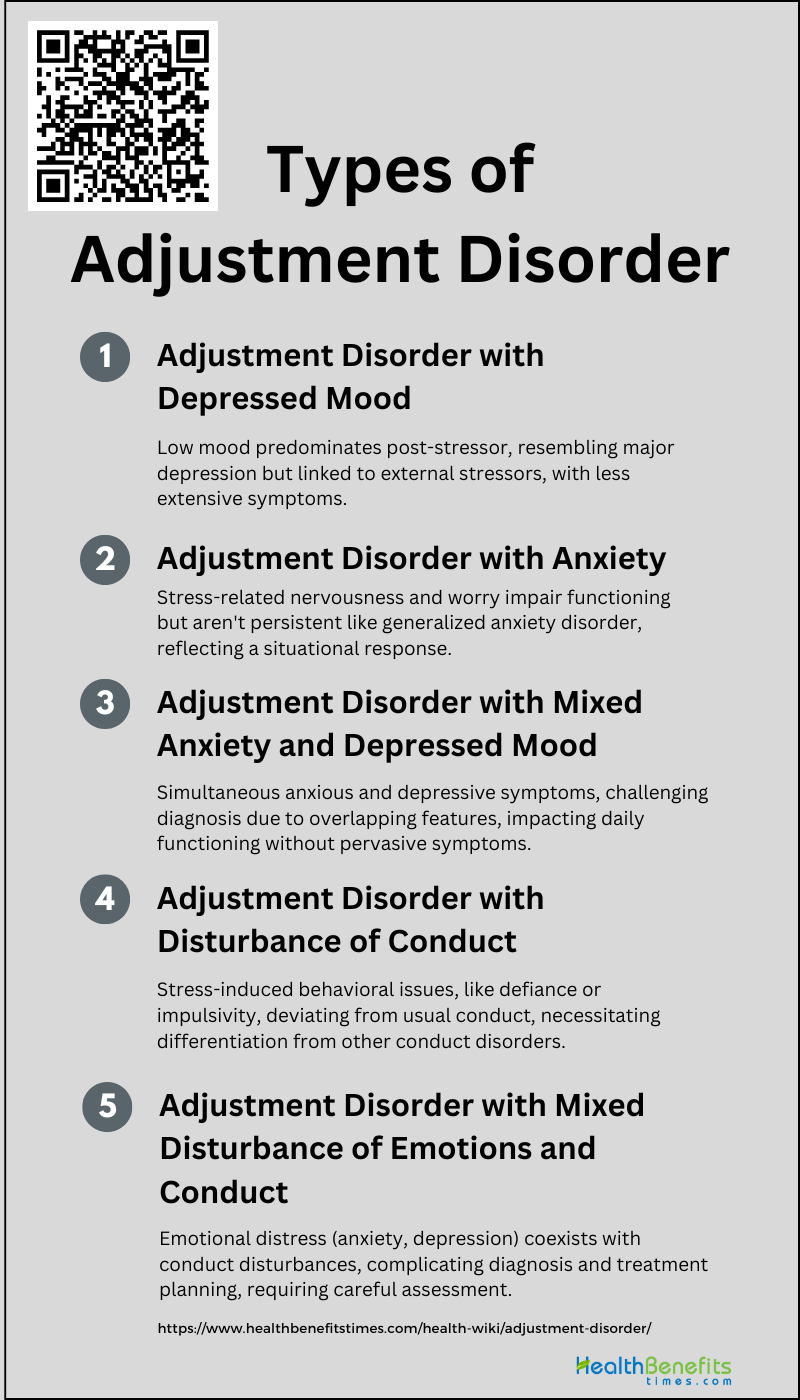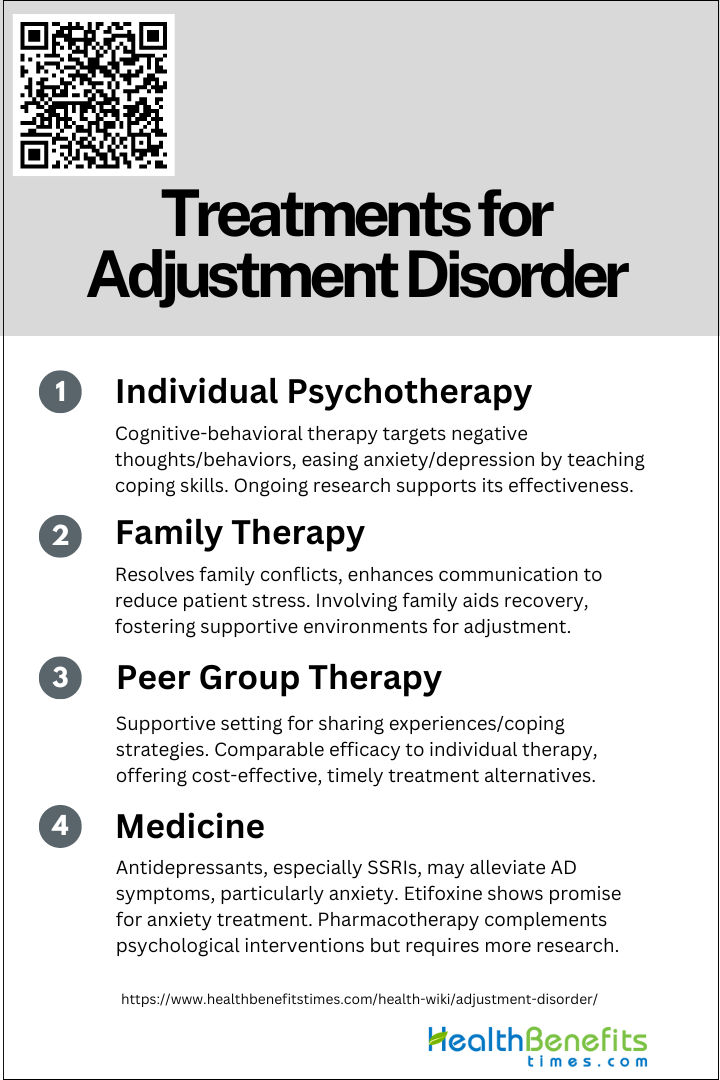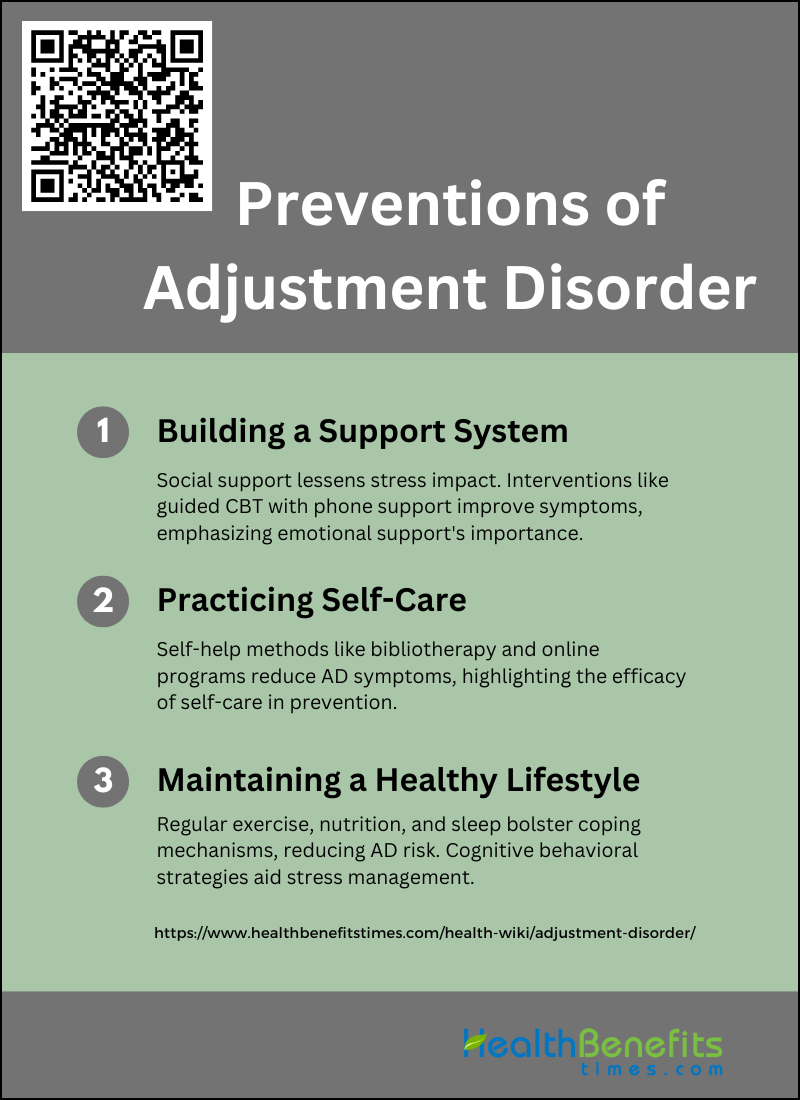 Adjustment Disorder (AD) is a short-term condition that occurs when an individual has an excessive reaction to a stressful life event or major life change, resulting in emotional and behavioral symptoms that interfere with daily functioning. It is characterized by the development of emotional or behavioral symptoms within three months of a stressful event, which may include depressed mood, anxiety, disturbance of conduct, or a combination of these symptoms. The symptoms are considered excessive or disproportionate to the severity of the stressor and cause significant impairment in social, occupational, or other important areas of functioning.
Adjustment Disorder (AD) is a short-term condition that occurs when an individual has an excessive reaction to a stressful life event or major life change, resulting in emotional and behavioral symptoms that interfere with daily functioning. It is characterized by the development of emotional or behavioral symptoms within three months of a stressful event, which may include depressed mood, anxiety, disturbance of conduct, or a combination of these symptoms. The symptoms are considered excessive or disproportionate to the severity of the stressor and cause significant impairment in social, occupational, or other important areas of functioning.
Causes of Adjustment Disorder
It manifests uniquely in each person, often triggered by a variety of factors. Below is a list of common causes that can lead to the development of an Adjustment Disorder.
- Retiring, getting married or having a baby
- Death of a loved one
- Relationship changes, including breakups, marital problems and divorce
- Receiving a medical diagnosis
- Difficulty at school or work
- Financial challenges
- An environmental disaster
- Not having your physical or emotional needs met
- Unexpected catastrophes
- Worries about money
Symptoms of Adjustment Disorder
The symptoms typically begin within three months of the onset of the stressor and are more severe than would be expected given the nature of the stressor. This disorder can affect individuals of any age and is characterized by a variety of symptoms, which can be categorized into emotional, behavioral, and sometimes physical manifestations. Here are the key symptoms that individuals with Adjustment Disorder may experience:
- Feeling sad, hopeless or not enjoying things you used to enjoy.
- Crying often.
- Worrying, or feeling anxious, nervous, jittery or stressed out.
- Feeling irritable or like you can’t handle anything and don’t know where to start.
- Having trouble sleeping.
- Not eating enough.
- Having difficulty concentrating.
- Having difficulty with daily activities.
- Withdrawing from family and friends who support you socially.
- Not doing important things, such as going to work or paying bills.
- Thinking about suicide or acting on those thoughts.
Complications of Adjustment Disorder
It can lead to several complications if not adequately addressed. While often temporary, it can have a range of complications if not addressed properly. These complications can interfere with a person’s daily functioning and overall well-being. Here are some of the potential complications associated with Adjustment Disorder:
- Anxiety disorder
- Major depression
- Substance abuse
- Self-harm
- Suicidal thinking
Types of Adjustment Disorder
Below is a list of the different types of Adjustment Disorders that individuals may encounter.
1. Adjustment Disorder with Depressed Mood
It is characterized by a predominant presence of low mood following an identifiable psychosocial stressor. Individuals may experience feelings of hopelessness and sadness, and show a lack of interest in activities they once enjoyed. This subtype of Adjustment Disorder is particularly challenging to distinguish from major depression, as both conditions share similar symptoms. However, Adjustment Disorder with depressed mood is specifically tied to an external stressor and the symptoms are not as extensive as those seen in major depressive episodes.
2. Adjustment Disorder with Anxiety
Individuals diagnosed with Adjustment Disorder with anxiety primarily exhibit symptoms of nervousness, worry, and apprehension that are in response to a stressful life event. Unlike generalized anxiety disorder, the anxiety experienced in this subtype of Adjustment Disorder is directly linked to the stressor and is not pervasive or persistent across all areas of life. The anxiety symptoms are significant enough to impair daily functioning but do not meet the criteria for a more chronic anxiety disorder.
3. Adjustment Disorder with Mixed Anxiety and Depressed Mood
This subtype of Adjustment Disorder presents with both anxious and depressive symptoms, but neither set of symptoms is predominant. Patients may feel overwhelmed by stress, experiencing a combination of worry, depressed mood, and difficulty in coping with daily tasks. The mixed symptoms can complicate the clinical picture, making it essential to differentiate from other mood and anxiety disorders where a stressor is not the primary cause.
4. Adjustment Disorder with Disturbance of Conduct
Adjustment Disorder with disturbance of conduct is marked by behavioral issues such as impulsivity, defiance, and violations of social norms or the rights of others. These behaviors are a response to stressful events and are not characteristic of the individual’s typical conduct. It is crucial to distinguish this subtype from other disorders with conduct symptoms, ensuring that the behaviors are understood within the context of a stressor.
5. Adjustment Disorder with Mixed Disturbance of Emotions and Conduct
This subtype involves both emotional symptoms (depression, anxiety) and a disturbance of conduct. Individuals may exhibit a mix of emotional distress and behavioral excesses or deficits in response to identifiable stressors. The complexity of this subtype lies in the co-occurrence of emotional and conduct symptoms, which requires careful assessment to ensure accurate diagnosis and appropriate treatment planning.
Treatments for Adjustment Disorder
Here are the primary treatments used to address this condition:
1. Individual Psychotherapy Using Cognitive-Behavioral Approaches
Individual psychotherapy, particularly cognitive-behavioral therapy (CBT), is a widely used treatment for adjustment disorder (AD). CBT focuses on identifying and modifying negative thought patterns and behaviors that contribute to the distress associated with AD. Studies have shown that CBT can effectively reduce symptoms of anxiety and depression in individuals with AD by teaching coping strategies and problem-solving skills. Despite the limited high-quality evidence, ongoing trials suggest that CBT remains a promising approach for managing AD symptoms, offering a structured and goal-oriented method to help patients adapt to stressful life changes.
2. Family Therapy
Family therapy is another therapeutic approach for treating adjustment disorder, particularly when family dynamics play a significant role in the individual’s stress response. This type of therapy aims to improve communication and resolve conflicts within the family unit, thereby reducing the overall stress experienced by the patient. Research indicates that family therapy can lead to better social adjustment and improved personal outcomes for patients living with family members. By involving family members in the treatment process, this approach helps create a supportive environment that can facilitate the patient’s recovery and adjustment to life changes.
3. Peer Group Therapy
Peer group therapy offers a supportive environment where individuals with adjustment disorder can share their experiences and coping strategies with others facing similar challenges. Group therapy has been shown to be as effective as individual therapy for some patients, providing a cost-effective alternative that can reduce waiting times for treatment. Cognitive-behavioral group therapy, in particular, has demonstrated efficacy in reducing symptoms of depression and anxiety, and improving quality of life among patients with AD. Additionally, mindfulness-based group therapy has been found to be non-inferior to individual CBT, making it a viable option for primary care patients with AD.
4. Medicine
Pharmacotherapy for adjustment disorder is less well-established compared to psychological interventions, but it can be beneficial for some patients. Antidepressants, such as selective serotonin reuptake inhibitors (SSRIs), have shown some efficacy in alleviating symptoms of AD, particularly when anxiety is a prominent feature. Etifoxine, an anxiolytic, has also been found to be more effective than buspirone and benzodiazepines for treating AD with anxiety. However, the overall quality of evidence for pharmacological treatments remains low, highlighting the need for more rigorously designed trials to better understand the benefits and limitations of these medications.
Preventions of Adjustment Disorder
To maintain mental well-being and prevent the onset of this condition, certain strategies can be implemented. Here are key preventative measures to consider:
1. Building a Support System
Building a robust support system is crucial in preventing adjustment disorder (AD). Social support can significantly mitigate the impact of stressors that trigger Ad. Studies have shown that interventions involving social support, such as guided internet-delivered cognitive behavioral therapy (CBT) with brief weekly telephone support, can lead to significant improvements in adjustment disorder symptoms, posttraumatic growth, and quality of life. Additionally, supportive psychotherapy has been found to be effective in managing AD, highlighting the importance of emotional and social support in treatment. Therefore, fostering a network of supportive relationships can be a key preventive measure against Ad.
2. Practicing Self-Care Regularly
Regular self-care practices are essential in preventing adjustment disorder. Self-help interventions, such as bibliotherapy and internet-based self-help programs, have shown promise in reducing symptoms of Ad. For instance, the ZIEL intervention, a self-guided online program, significantly reduced depressive symptoms and improved quality of life among participants. Similarly, a cognitive behavioral self-help manual was effective in alleviating AD symptoms in burglary victims, demonstrating the potential of self-care strategies in managing stress and preventing disorder escalation. Engaging in regular self-care activities can thus play a vital role in maintaining mental health and preventing Ad.
3. Maintaining a Healthy Lifestyle
Maintaining a healthy lifestyle is another important strategy for preventing adjustment disorder. A healthy lifestyle, which includes regular physical activity, balanced nutrition, and adequate sleep, can enhance stress-coping mechanisms and overall well-being. Research indicates that psychological adjustment to chronic illness is facilitated by staying active, managing emotions, and focusing on positive outcomes. Additionally, cognitive behavioral principles, such as stress inoculation training and graded activity, are recommended for managing stress-related disorders in occupational settings9. By adopting a healthy lifestyle, individuals can strengthen their resilience against stressors and reduce the risk of developing Ad.




